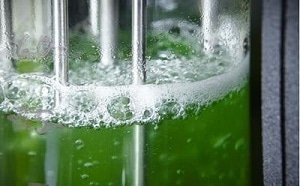Sep 8 2016
 Synechococcus brewing in a bioreactor. Credit: Pacific Northwest National Laboratory. (Credit: University of Southampton)
Synechococcus brewing in a bioreactor. Credit: Pacific Northwest National Laboratory. (Credit: University of Southampton)
University of Southampton scientists have redesigned the fundamental process of photosynthesis used to power valuable chemical reactions capable of being used to generate fine chemicals, pharmaceuticals and biofuels.
Photosynthesis is considered to be a key biological reaction on the planet as it provides the food consumed by human beings and the oxygen they breathe, and removes CO2 from the atmosphere.
Photosynthesis in algae and plants comprises of two reactions: the dark-reactions use the protons and the electrons from the reactions to ‘fix’ CO2 from the atmosphere into simple sugars that form the basis of the food chain, and the light-reactions absorb light energy from the sun and use it to divide water (H2O) into oxygen, protons and electrons.
Compared to the dark reactions, the light reactions have a much higher capacity, resulting in an increasing amount of the absorbed light energy being wasted as heat instead of being used to ‘fix’ CO2.
In our study, we used synthetic biology methods to engineer an additional enzyme in-between the light-reactions and before the dark-reactions. We have therefore ‘rewired’ photosynthesis such that more absorbed light is used to power useful chemical reactions. This study therefore represents an innovation whereby a range of additional valuable chemical reactions can be powered by the sun in plants and algae.
Dr Adokiye Berepiki, Postdoctoral Research Fellow, University of Southampton
A report featured in ACS Synthetic Biology highlights that the ‘wasted’ electrons were rewired in order to degrade the spreading of atrazine, an environmental pollutant also known as a herbicide used in agriculture. The use of atrazine has been banned by the EU for more than 20 years. However, atrazine still continues to be a commonly used pesticide in groundwater.
The photosynthetic algae developed by the researchers could be used in the efficient bioremediation of similar wastewater areas that are polluted.
Dr Berepiki said: “By taking a synthetic biology approach – combining science, technology and engineering to facilitate and accelerate the design, manufacture and modification of genetic materials in living organisms – we rewired electrons by introducing an enzyme from a brown rat into the photosynthetic machinery. This enzyme, which was encoded by a gene that was produced de novo using chemical synthesis rather than being taken from rat, was then able to serve as an electron sink that used photosynthetic electrons to power its activity.”
There has been much recent research into the potential of using photosynthetic species as sources of sustainable biofuels. While promising, this potential is not yet economically feasible. The ‘added value’ we have introduced into algal may therefore be a critical step toward the commercial realisation of using photosynthetic species to generate ‘biofuels’ that may one day replace our current dependence on fossil fuels.
Tom Bibby, Professor, University of Southampton